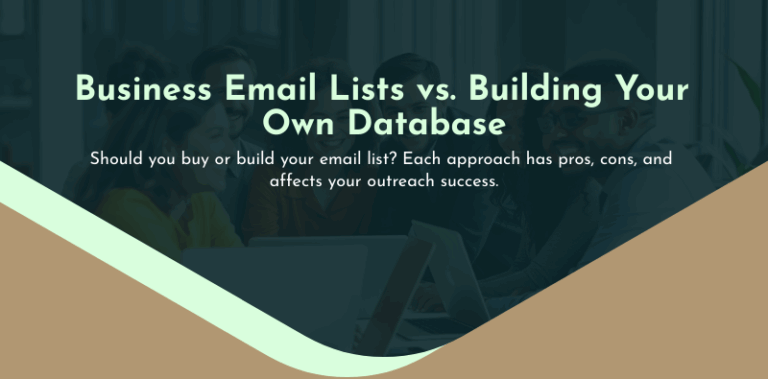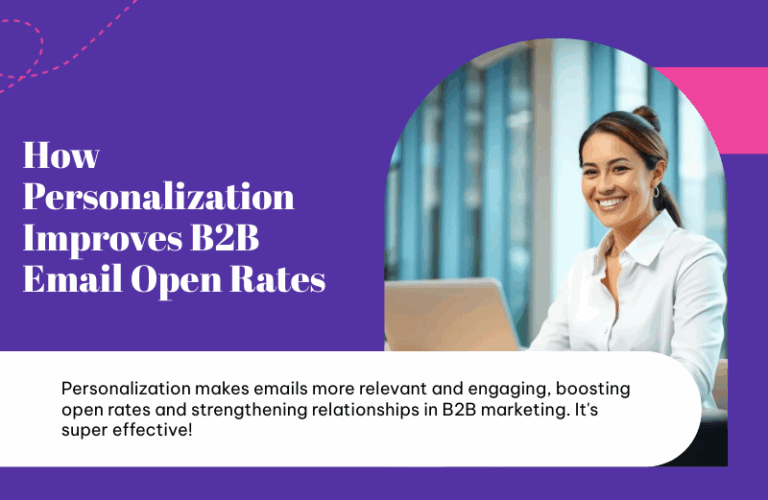
Email remains one of the most powerful tools for reaching your audience. However, the question of whether and how to use purchased email lists responsibly often sparks debate. Missteps can result in not only wasted resources but also legal and reputational risks. Here’s a guide to ensure your efforts are both ethical and effective.
Are Purchased Email Lists Legal?
The legality of purchased email lists varies across regions. For instance, in the United States, the CAN-SPAM Act permits the use of purchased lists, provided recipients can opt out, and emails adhere to strict labeling rules. However, this doesn’t absolve businesses from reputational risk or compliance challenges. In the EU, the General Data Protection Regulation (GDPR) strictly prohibits sending marketing emails without explicit consent. Understanding these legal frameworks ensures you remain compliant while leveraging your email campaigns.
Why Vetting is Crucial
A poorly vetted email list can damage your sender reputation, leading to lower deliverability rates or blacklisting by internet service providers (ISPs). To avoid this:
- Check list quality: Ensure the list is from a reputable provider with transparent sourcing methods.
- Analyze segmentation: Look for targeted audiences relevant to your business goals.
- Assess data freshness: Verify that the data is recent; outdated lists often include inactive or invalid addresses.
Best Practices for Using Purchased Email Lists
Even with a vetted list, caution is essential to avoid missteps. Here’s how to send purchased email lists effectively while protecting your brand.
1. Warm Up Your Domain
Before deploying large-scale campaigns, establish a positive sender reputation by sending emails to a smaller, engaged audience. This prevents ISPs from flagging your messages as spam.
2. Craft a Strong Introduction
Your first contact with recipients should acknowledge their inclusion on your list and offer a clear value proposition. Transparent messaging builds trust and encourages engagement.
3. Use Double Opt-In Methods
Encourage recipients to confirm their interest in your emails. This not only improves list quality but also ensures compliance with regulations like GDPR and CCPA.
How to Vet a Purchased Email List
Vetting is an art and science. Beyond basic checks, use advanced techniques to ensure your list’s integrity.
Tools and Techniques for Verification
- Email Validation Services: Services like NeverBounce or ZeroBounce can verify addresses and remove invalid ones.
- Engagement Metrics: Analyze open and click rates from test campaigns to gauge interest.
- Spam Trap Avoidance: Cross-check lists for known spam traps, which can harm your sender score.
For further insights on email marketing, consider exploring strategies like B2B email campaigns.
Challenges and Risks
Spam Complaints
Even with the most vetted list, purchased lists tend to generate higher spam complaints compared to organic ones. Mitigate this by clearly stating the email’s purpose and including an easy-to-find opt-out option.
Low Engagement Rates
Recipients from purchased lists may not be familiar with your brand, leading to lower engagement. Personalizing content and segmenting the list based on interest can improve these metrics.
How to Integrate Purchased Lists with Existing Campaigns
Integration is key to making purchased lists a part of your broader strategy without overwhelming your system or alienating your audience.
Segmentation is Key
Divide your list based on demographics, interests, or past interactions. This ensures tailored messaging for different audience groups.
Automation Tools
Use marketing automation platforms to manage and monitor campaigns efficiently. Systems like HubSpot or Marketo provide analytics to optimize performance.
Explore the role of marketing automation in integrating multiple audience types and streamlining workflows.
Ethical Considerations
Marketing ethics demand that purchased lists be used responsibly. This not only fosters trust but also strengthens long-term relationships with potential customers.
Transparency
Inform recipients about how you obtained their contact information. Honesty encourages trust and prevents complaints.
Value-Driven Communication
Always prioritize value in your emails. Whether it’s a special offer, free resource, or insightful content, ensure your audience benefits.

Examples of Responsible Use Cases
Re-Engagement Campaigns
Purchased lists are excellent for re-engagement, especially if they contain past customers or leads. A friendly “We Miss You” campaign can reignite interest.
Expanding Reach
If you’re targeting a new market segment, a reputable purchased list can provide a starting point for your efforts.
Explore more examples of innovative strategies in lead generation for SaaS companies.
Metrics to Monitor
Measuring the success of your campaigns is crucial. Keep an eye on these metrics:
- Bounce Rate: High rates suggest poor-quality data.
- Open and Click-Through Rates: These indicate engagement levels.
- Complaint Rate: Monitor spam complaints to identify potential issues.
The Role of Data Hygiene
Regular maintenance of your email lists is vital. Removing inactive users, updating contact information, and eliminating duplicates keep your list clean and effective.
Learn more about how data quality impacts campaigns through data enhancement techniques.
Alternatives to Purchased Lists
If you’re hesitant about using purchased email lists, there are other methods to grow your database organically:
- Content Marketing: Create valuable resources that encourage sign-ups.
- Social Media Campaigns: Leverage paid ads to drive email subscriptions.
- Networking Events: Collect contacts through in-person or virtual engagements.
Maximizing ROI with Purchased Email Lists
Purchased email lists can seem like a shortcut to marketing success, but leveraging them effectively requires strategy and a nuanced approach. Here’s how to align purchased lists with a broader email marketing strategy to maximize ROI and enhance audience engagement.
Why Businesses Consider Purchased Email Lists
Companies often turn to purchased email lists to:
- Expand Outreach Quickly: Access a large, ready-made pool of potential leads.
- Kickstart Marketing Campaigns: Generate awareness in a new market segment.
- Target Specific Niches: Use lists tailored to demographics or industry-specific data.
Despite these advantages, understanding the risks and preparing for the challenges is vital for success.
Key Considerations Before Purchasing
Quality Over Quantity
A large list might seem appealing, but smaller, highly-targeted lists often yield better results. Reputable providers ensure their lists are segmented by factors like:
- Industry
- Geographic region
- Role within the company (e.g., decision-makers)
Vendor Vetting
Ask potential vendors these critical questions:
- How is the list sourced?
- Are contacts validated regularly?
- Can the provider guarantee compliance with local and international laws?
A transparent vendor will readily provide this information, ensuring you make an informed decision.
How to Vet a Purchased Email List
Purchased email lists come with inherent risks, but careful vetting minimizes the potential downsides.
- Run a Test Campaign: A small, targeted trial allows you to measure engagement before scaling.
- Verify Deliverability Rates: Use email verification tools like Mailgun or Hunter to identify invalid addresses.
- Review Past Complaints: If the vendor has a history of providing problematic lists, steer clear.
Crafting the Perfect Email for Purchased Lists
Purchased lists demand precision in email marketing. Your content must be compelling enough to capture the attention of recipients unfamiliar with your brand.
Subject Line Best Practices
- Keep it under 50 characters.
- Personalize when possible (e.g., “Hi [First Name], let’s talk solutions!”).
- Use action-oriented language to spark curiosity.
Body Content Essentials
- Start with a clear, concise introduction explaining your value.
- Include social proof, like case studies or testimonials, to build trust.
- End with a strong, actionable call-to-action (CTA).
Avoiding Common Mistakes
Overloading Recipients
Flooding recipients with too many emails is a common misstep that leads to high unsubscribe rates. Limit initial outreach to one or two emails per week.
Neglecting Segmentation
A generic message sent to an unsegmented list is likely to fail. Segment based on shared characteristics such as job title, industry, or geographic location.
Failing to Follow Up
Purchased lists are often less engaged than organic lists. Follow-up emails, especially ones that address previous non-responses, help in re-establishing interest.
Regulatory Compliance in Practice
United States (CAN-SPAM Act)
Compliance involves providing a clear opt-out mechanism, truthful subject lines, and identifying the message as an advertisement. Always include your company’s physical mailing address.
European Union (GDPR)
GDPR requires explicit consent. Purchased lists often lack such consent, making them risky. If targeting EU residents, consider alternative strategies to obtain compliant lists.
Canada (CASL)
Under CASL, businesses must obtain express or implied consent before sending commercial emails. Unlike the U.S., penalties are steep for violations.
Alternatives to Consider
If purchased lists seem too risky or ineffective, explore these strategies for growing your list organically:
- Interactive Webinars: Host events tailored to industry challenges, inviting participants to register with their email addresses.
- Incentivized Referrals: Encourage current subscribers to refer peers in exchange for discounts or exclusive access.
- Social Media Ads: Use lead generation forms on platforms like LinkedIn and Facebook to target precise demographics.

Advanced Tools for Email Success
Integrating automation and analytics tools ensures you derive maximum value from your campaigns.
Marketing Automation Platforms
Platforms like Pardot or ActiveCampaign help with segmentation, timing, and testing campaigns across diverse audiences.
A/B Testing
Experiment with different subject lines, CTAs, or visuals to see what resonates with your purchased list. Monitor key metrics like open rates and click-through rates to refine your approach.
Long-Term Relationship Building
Once you’ve engaged with recipients from a purchased list, transitioning them into loyal customers is the next challenge.
- Personalized Follow-Ups: Tailor messaging to align with their behavior (e.g., clicking a specific link).
- Exclusive Offers: Provide deals or discounts that feel personalized, incentivizing continued engagement.
- Ongoing Value Delivery: Share valuable resources regularly to nurture the relationship over time.
Final Thoughts
Using purchased email lists is not inherently bad, but the way you approach the process defines its success. By vetting your lists, understanding legal obligations, and integrating responsible practices, you can maximize ROI while maintaining compliance and trust.
For those ready to elevate their marketing strategies, consider diving into advanced approaches, like leveraging email marketing automation to streamline and personalize campaigns.
Related Resources:



